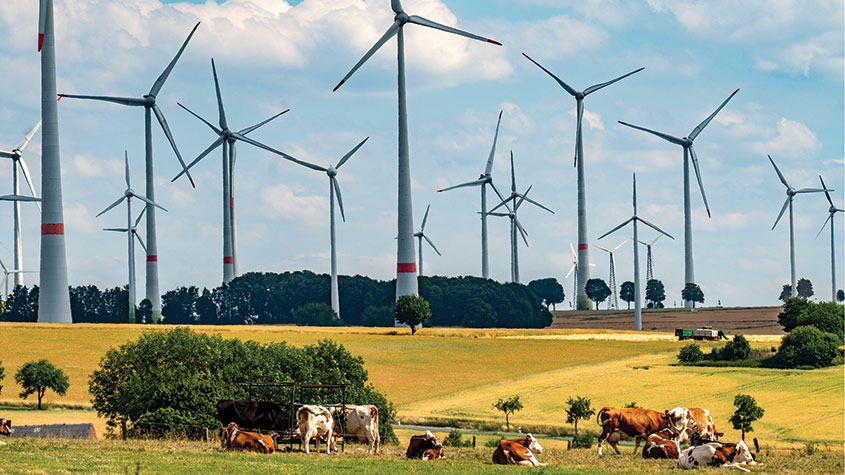4 investment trusts to buy yielding up to 12%
Widening discounts present a buying opportunity for these four high-yielding investment trusts


Listed income funds, in particular investment trusts, have had a tough few months.
With UK 10-year Gilts now yielding around 4% we’re seeing a massive repricing of risk. This has fed into the valuation models used by funds and investment trusts (they’re increasing their discount rates) and affected what investors demand.
If the UK government will pay you a return of 4% per year over 10 years, why take an extra private-sector risk for a yield of 4.5%? Suddenly, anything yielding below 5% looks less enticing (luckily dividend yields on equities are rising).
MoneyWeek
Subscribe to MoneyWeek today and get your first six magazine issues absolutely FREE

Sign up to Money Morning
Don't miss the latest investment and personal finances news, market analysis, plus money-saving tips with our free twice-daily newsletter
Don't miss the latest investment and personal finances news, market analysis, plus money-saving tips with our free twice-daily newsletter
This has crept up the yield ladder and even affected funds that yield substantially over 5%.
As a result, investment trust discounts have widened, often despite relatively good news still coming from the underlying investments.
Four promising investment trusts
Take Riverstone Credit Opportunities (LSE: RCOI), which lends to a range of borrowers in the energy market, increasingly in clean energy.
The managers behind the fund have a great record and many of the loans in the portfolio have been refinanced or repaid, frequently triggering early repayment fees.
It’s a similar story with BioPharma Credit (LSE: BPCR), which lends to publicly listed life sciences companies who’d rather raise debt than issue equity at very low valuations. The trust’s repayment record is outstanding and it’s frequently making extra fees from repayments.
Both of these funds are sensibly and conservatively run, with generous yields (of 9% and 12%) respectively, and good performance histories. Riverstone is trading at a 24% discount to net asset value (NAV) and BioPharma at 7%.
EJF Investments (LSE: EJFI) is one of a handful of investment trusts that specialises in lending and debt financing rather than owning equities.
It mainly lends money to smaller US banks and insurance companies, as well as investing in mortgage-servicing rights that benefit from higher interest rates. The typical deal involves wrapping up lending within a complex package that involves different levels of risk. This could make it risky, but EJF has form in this arena and knows its segment, often managing the securitisation of the loans.
NAV has been increasing in recent months as its borrowers benefit from higher rates. In September the fund reported a monthly NAV increase of 2.5%. That took the year-to-date NAV return (including income paid out) to 17.8% and the annualised return since inception to 13%. EJF now trades on a yield of 9% and a 37% discount.
Income investment trusts trade with huge discounts
RM Infrastructure Income (LSE: RMII) has recently been shifting its strategy from direct lending to businesses to becoming more of an infrastructure-backed lender.
Its main focus is project finance: getting a development or project built before it can produce an income. Project financing comprises over 70% of the portfolio.
The fund has a senior position (or a guarantee from the government) on more than 60% of its loan book. Junior loans or other positions in the debt structure account for over a third of the portfolio.
RMII’s total net asset return over the last 12 months has been 2.73%, and since January 2020 the NAV total return has been 14.81%. The return since inception has been 35.19%. It is on at a discount of 14% and yields 8%.
It might not be the cheapest of the investment trusts in this article, but it does have some highly attractive qualities.
Buy at a discount
Back in the days of low interest rates, yields above 8% raised red flags. But the environment has changed and plenty of fairly sensible borrowers are now facing rates of between 8% and 12%.
Bonds that pay yields of between 8% and 10% will remain attractive as long as you can trust the lenders to get the money back.
Crucially, all four funds lend across a useful range of underlying sectors. Most borrowers will undoubtedly face a tough 18 months, but I think the extra risk is worth it given the yields. Additionally the chunky discounts to NAV could even begin to tighten if interest rates were to fall back in the not too distant future.
Get the latest financial news, insights and expert analysis from our award-winning MoneyWeek team, to help you understand what really matters when it comes to your finances.

David Stevenson has been writing the Financial Times Adventurous Investor column for nearly 15 years and is also a regular columnist for Citywire.
He writes his own widely read Adventurous Investor SubStack newsletter at davidstevenson.substack.com
David has also had a successful career as a media entrepreneur setting up the big European fintech news and event outfit www.altfi.com as well as www.etfstream.com in the asset management space.
Before that, he was a founding partner in the Rocket Science Group, a successful corporate comms business.
David has also written a number of books on investing, funds, ETFs, and stock picking and is currently a non-executive director on a number of stockmarket-listed funds including Gresham House Energy Storage and the Aurora Investment Trust.
In what remains of his spare time he is a presiding justice on the Southampton magistrates bench.
-
 Metals and AI power emerging markets
Metals and AI power emerging marketsThis year’s big emerging market winners have tended to offer exposure to one of 2025’s two winning trends – AI-focused tech and the global metals rally
-
 8 of the best houses for sale with beautiful fireplaces
8 of the best houses for sale with beautiful fireplacesThe best houses for sale with beautiful fireplaces – from a 15th-century cottage in Kent to a 17th-century palazzo in Oxfordshire
-
 Halifax: House price slump continues as prices slide for the sixth consecutive month
Halifax: House price slump continues as prices slide for the sixth consecutive monthUK house prices fell again in September as buyers returned, but the slowdown was not as fast as anticipated, latest Halifax data shows. Where are house prices falling the most?
-
 Rents hit a record high - but is the opportunity for buy-to-let investors still strong?
Rents hit a record high - but is the opportunity for buy-to-let investors still strong?UK rent prices have hit a record high with the average hitting over £1,200 a month says Rightmove. Are there still opportunities in buy-to-let?
-
 Pension savers turn to gold investments
Pension savers turn to gold investmentsInvestors are racing to buy gold to protect their pensions from a stock market correction and high inflation, experts say
-
 Where to find the best returns from student accommodation
Where to find the best returns from student accommodationStudent accommodation can be a lucrative investment if you know where to look.
-
 The world’s best bargain stocks
The world’s best bargain stocksSearching for bargain stocks with Alec Cutler of the Orbis Global Balanced Fund, who tells Andrew Van Sickle which sectors are being overlooked.
-
 Revealed: the cheapest cities to own a home in Britain
Revealed: the cheapest cities to own a home in BritainNew research reveals the cheapest cities to own a home, taking account of mortgage payments, utility bills and council tax
-
 UK recession: How to protect your portfolio
UK recession: How to protect your portfolioAs the UK recession is confirmed, we look at ways to protect your wealth.
-
 Buy-to-let returns fall 59% amid higher mortgage rates
Buy-to-let returns fall 59% amid higher mortgage ratesBuy-to-let returns are slumping as the cost of borrowing spirals.